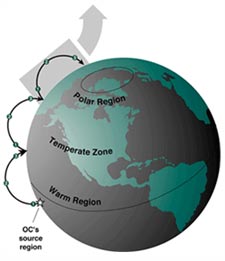TRANSBOUNDARY POLLUTION FACT SHEET
“Humankind has not woven the web of life. We are but one thread within it. Whatever we do to the web, we do to ourselves. All things are bound together. All things connect.” -Chief Seattle, 1855
What is Transboundary Pollution?
Transboundary pollution is the pollution that originates in one country but is able to cause damage in another country’s environment, by crossing borders through pathways like water or air. Pollution can be transported across hundreds and even thousands of kilometers. The incredible distances that pollution can spread means that it is not contained within the boundaries of any single nation. This is why it is called ‘Transboundary Pollution’. One of the problems with transboundary pollution is that can carry pollution away from a heavy emitter and deposit it onto a nation whose emissions are relatively low. Another problem with transboundary pollution relates to the quote above. Due to the fact that ‘All things connect’, the heavy pollution that is evident in the developed world also becomes evident in remote areas. For an example of how transboundary pollution becomes visible in a remote area like the Arctic, see the Arctic Haze fact sheet.
How does Transboundary Pollution Travel?
Wind Transportation of Contaminants:
Wind Currents like those shown below bring pollution from the South to the Arctic.
River Transportation of Contaminants:
The flow of rivers shown below that end up in the Arctic Ocean also shows how contaminants are carried from places such as Russia, which may still carry large deposits of PCBs and other contaminants.
Ocean Transportation of Contaminants:
Other contaminants may travel to the Arctic on Ocean currents. As this illustration shows, many of the major ocean currents flow through the Arctic. These strong winds and currents flowing to the Arctic transport pollution to the Arctic and the cold temperature of this environment acts as a "storage" place for these contaminants.
Grasshopper Effect
Persistent Organic Pollutants (POPs) are able to travel great distances by attaching to dust particles that are blown north by the wind when there is no precipitation. When precipitation occurs, POPs are transported to the ground where they will then evaporate and begin travelling north again. Once they reach the far north, however, the colder temperatures trap them and allow for their presence in the Arctic to become concentrated. For more information about POPs, see the Persistent Organic Pollution fact sheet.
Arctic Seabirds
The droppings (guano) of Arctic Seabirds are another way that human made pollutants from the south arrive and concentrate in the Arctic. The levels of pollutants like mercury and DDT have been found to be as much as 60 times greater than those found at sites not influenced by seabirds. Since the guano is also an important source of fertilizer for the Arctic, many other forms of Arctic life centre around these areas in which contaminants become concentrated. This leads to the pollutants making their way into all levels of the Arctic food web. The seabirds acquire pollutants through contact with polluted ocean waters and food sources. These waters and food sources became themselves polluted through some of the mechanisms of transport mentioned above. In other words, the birds act as a taxi service for ocean borne pollutants to travel inland.
Photo credit: Mark Mallory, Iqaluit, NU, Canada
Did you know that our Operation Water Pollution program teaches students about what water pollution is, what causes it, how it is cleaned up, and what they can do about the problem? Operation Water Pollution kits, which accompany the Operation Water Pollution program, consist of a digital pH meter and a digital TDS meter, both of which are guaranteed to be reusable for at least two years. Please help us to send more Operation Water Pollution kits to schools! Please chip in $5 or donate $20 or more and receive an Official Donation Receipt for Income Tax Purposes - or donate $170 to provide a school with an Operation Water Pollution kit.
Resources:
Inuit Tapiriit Kanatami
https://www.itk.ca/
Arctic Seabirds Transport Marine-Derived Contaminants; Jules M. Blais, Lynda E. Kimpe, Dominique McMahon, Bronwyn E. Keatley, Mark L. Mallory, Marianne S.V. Douglas, John P. Smol
https://www.science.org/doi/10.1126/science.1112658
Transboundary Pollution: Definition
http://stats.oecd.org/glossary/detail.asp?ID=2754






